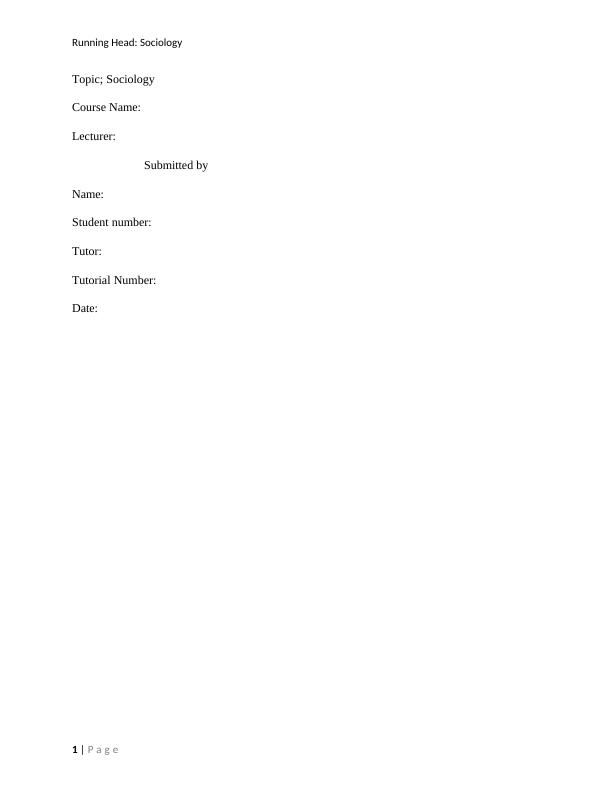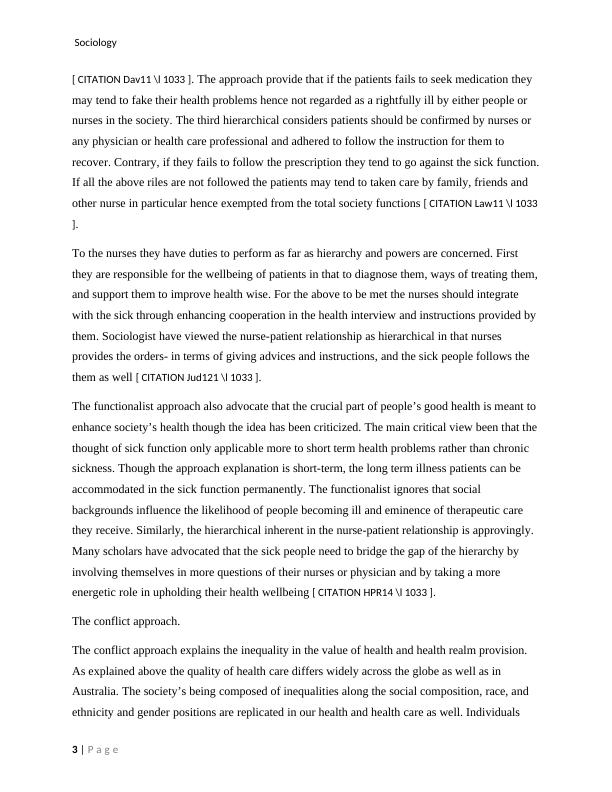Course Description: Multidimensional Health
Added on 2020-03-16
9 Pages2685 Words287 Views
Running Head: SociologyTopic; SociologyCourse Name:Lecturer: Submitted by Name:Student number:Tutor:Tutorial Number:Date:1|P a g e

SociologyIntroductionHealth refers to the level of people’s physical, mental and social being as well. In other words health is multidimensional model. According to sociological perception, the three dimensions mentioned above can be integrated as far as for individual to be in good condition, that is, physical and poor mental health. On the other hand health care can be said as the facility of medical services to protect, diagnose and nurse health complications. Sociological explanation ofhealth and health care gives a comprehensive understanding than any explanation given elsewhere [ CITATION RSt09 \l 1033 ]. The functionalist approachThe functionalist perspective explains that good health and effective medical care are genesis of essential for the better society’s capability to function. For instance the Australian society have to be well equipped with medical facilities for the people to participate in daily activities which contribute to the growth of the country. For the nursing department in the country, better facilities and working condition should be adhered to for the health workers well-being. The approach also advocate that ill health facilities provoke the performance of nurses in hospitals who are part and parcel of the society since if the community is have health issues, societies functionality and steadiness grieves. More specifically, the approach emphasizes the cause of premature deaths are as the root cause of nurses and health occupants failing to fully contribute to the social function. Thus it lead to poor return to the community as a result of various effects like birth, child care, and socialization of native who ends terminating their life early. Likewise, the poor medication marks another dysfunctional for the society [ CITATION Pet102 \l 1033 ]. The people who got ill encounter problems in becoming healthy and individual who are seem to be healthy become ill and vice versa.For the individuals to be declared sick he/she must follow the hierarchical order to be diagnosed. First, the sick function. The patient must be considered justifiably sick and some viable expectations must be met. Nurses should not perceive the patient as the main cause of their health problem. Instead they should advice on the eating model such as high-fat food, leads to obese and likely to be affected by heart attack. The nurses should induce less sympathy than if they experienced good nutrition and maintained good health as well. Secondly, sick people should appeal to get well. In other words they should seek medical facilities from nurses2|P a g e

Sociology[ CITATION Dav11 \l 1033 ]. The approach provide that if the patients fails to seek medication they may tend to fake their health problems hence not regarded as a rightfully ill by either people or nurses in the society. The third hierarchical considers patients should be confirmed by nurses or any physician or health care professional and adhered to follow the instruction for them to recover. Contrary, if they fails to follow the prescription they tend to go against the sick function.If all the above riles are not followed the patients may tend to taken care by family, friends and other nurse in particular hence exempted from the total society functions [ CITATION Law11 \l 1033]. To the nurses they have duties to perform as far as hierarchy and powers are concerned. First they are responsible for the wellbeing of patients in that to diagnose them, ways of treating them,and support them to improve health wise. For the above to be met the nurses should integrate with the sick through enhancing cooperation in the health interview and instructions provided by them. Sociologist have viewed the nurse-patient relationship as hierarchical in that nurses provides the orders- in terms of giving advices and instructions, and the sick people follows the them as well [ CITATION Jud121 \l 1033 ]. The functionalist approach also advocate that the crucial part of people’s good health is meant to enhance society’s health though the idea has been criticized. The main critical view been that thethought of sick function only applicable more to short term health problems rather than chronic sickness. Though the approach explanation is short-term, the long term illness patients can be accommodated in the sick function permanently. The functionalist ignores that social backgrounds influence the likelihood of people becoming ill and eminence of therapeutic care they receive. Similarly, the hierarchical inherent in the nurse-patient relationship is approvingly. Many scholars have advocated that the sick people need to bridge the gap of the hierarchy by involving themselves in more questions of their nurses or physician and by taking a more energetic role in upholding their health wellbeing [ CITATION HPR14 \l 1033 ].The conflict approach.The conflict approach explains the inequality in the value of health and health realm provision. As explained above the quality of health care differs widely across the globe as well as in Australia. The society’s being composed of inequalities along the social composition, race, and ethnicity and gender positions are replicated in our health and health care as well. Individuals 3|P a g e

End of preview
Want to access all the pages? Upload your documents or become a member.
Related Documents
The Role of Power and Hierarchy in Healthcare: A Sociological Perspectivelg...
|10
|2551
|52
Hierarchy and Power in the Current Healthcare System in Australialg...
|10
|2928
|396
NUR210 Health Sociology Assessment 2lg...
|9
|2782
|104
Evaluating Quality in Health and Social Carelg...
|15
|4586
|392
NUR210 Role of Power and Hierarchy in Medical Sociologylg...
|11
|3327
|63
Sociological Theories to Explain the Determinants of Healthlg...
|7
|2010
|284
